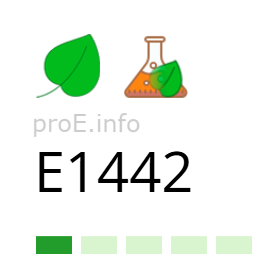
Other names for the additive (synonyms)
General Information
Food additive E1442 — distarch phosphate hydroxypropylated or hydroxypropyl starch phosphate belongs to the group of modified starches (not to be confused with genetically modified starches). It is used in the food industry as an emulsifier, thickener, and stabilizer.
In nature, pure hydroxypropyl starch phosphate does not occur; however, ordinary starch from natural sources (potato, corn, etc.) is used as raw material for producing additive E1442.
For the food industry, additive E1442 is produced by esterification of starch with sodium trimetaphosphate or phosphorus oxychloride followed by treatment with propylene oxide. During this process, chemical "cross-linking" of starch molecules occurs, increasing resistance to heat, freezing, and pH changes.
The chemical formula of hydroxypropyl distarch phosphate is C3H8O2·xH3O4P·x (exact composition depends on the degree of modification). Physically, it is a white or slightly yellowish granular powder, odorless, and well dispersible in water.
Additive E1442 was developed as an improved starch variant to enhance product stability during heat treatment and storage.
Effects on the Body
Benefits of Additive E1442
Additive E1442 is not essential for the human body and does not provide any specific benefits. It is metabolized similarly to ordinary starch: hydrolyzed in the gastrointestinal tract into glucose, which the body uses as an energy source. During hydrolysis, intermediate products — dextrins (polysaccharides) — are formed.
Risks of Additive E1442
Under normal consumption of products containing additive E1442, no health risks have been identified. Excessive intake of starch, including modified starch, may slow down food digestion, cause flatulence, nausea, and a feeling of stomach fullness.
The EFSA Panel on Food Additives and Nutrient Sources added to Food (ANS), in its 2017 evaluation, confirmed the safety of modified starches including E1442 and did not set an Acceptable Daily Intake (ADI).
The JECFA (Joint FAO/WHO Expert Committee on Food Additives) also concluded that there is no need for a specific ADI for modified starches as they are metabolized like ordinary starch. The FDA (USA) classifies E1442 as GRAS (Generally Recognized As Safe).
All committees concluded that modified starches are not absorbed by the human body unchanged, but are significantly hydrolyzed by intestinal enzymes and subsequently fermented by gut microbiota. Available studies showed no short- or long-term risks of toxicity or carcinogenicity. Modified starches also do not affect reproductive organs.
Uses
In the food industry, additive E1442 is used as a thickener, stabilizer, and emulsifier. Main areas of application include:
- Dairy products (yogurts, desserts, ice cream)
- Sauces, mayonnaises, dressings
- Canned soups and ready meals
- Frozen products to improve texture after thawing
The use of additive E1442 helps maintain product uniformity and prevent liquid separation, improves appearance, and enhances resistance to heating and freezing.
Legal Status
Additive E1442 is permitted for use in most countries worldwide, including Ukraine. In the European Union, it is allowed without a specific ADI and regulated by Regulation (EC) No 1333/2008.
In the USA, it holds GRAS status (Generally Recognized As Safe), in Canada it is permitted under the "List of Permitted Food Additives," and in Australia and New Zealand its use is regulated by the FSANZ Food Standards Code.